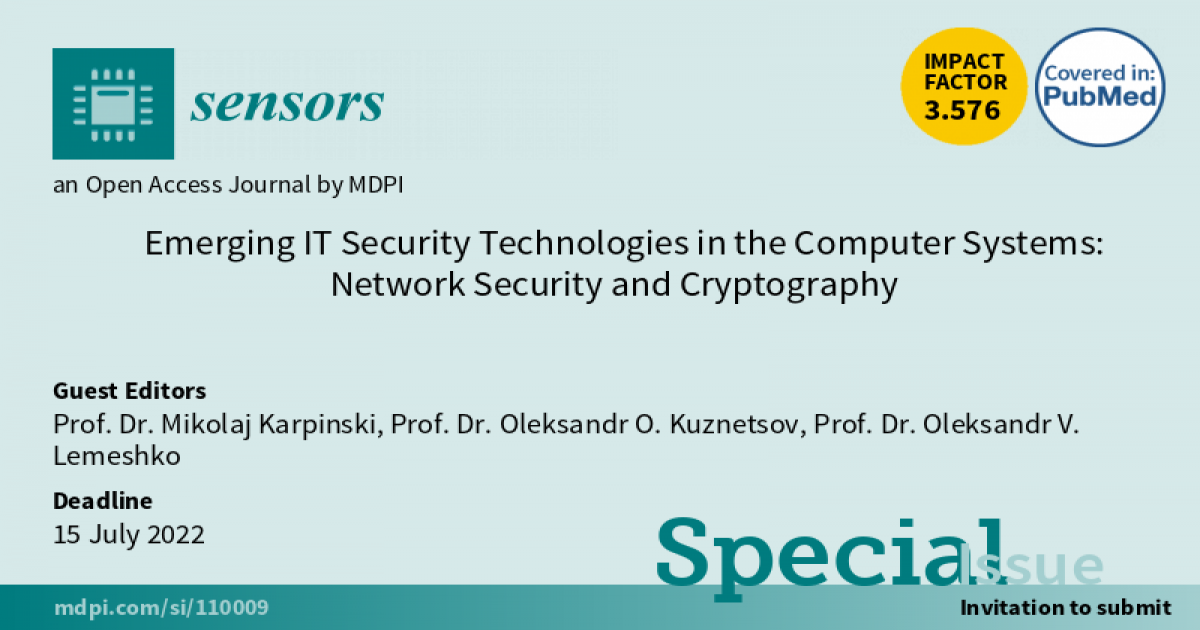Emerging IT Security Technologies in the Computer Systems: Network Security and Cryptography
A special issue of Sensors (ISSN 1424-8220). This special issue belongs to the section "Sensor Networks".
Deadline for manuscript submissions: closed (15 July 2022) | Viewed by 17503

Special Issue Editors
Interests: computer networks and wireless communication; computer security and cryptography; computing systems
Special Issues, Collections and Topics in MDPI journals
2. Department of Political Sciences, Communication and International Relations, University of Macerata, Via Crescimbeni, 62100 Macerata, Italy
Interests: noise-tolerant transmission of information; algebraic code theory; authentication theory; cryptography and steganography
Special Issues, Collections and Topics in MDPI journals
Interests: traffic management; optimization and quality of service in infocommunications; wireless networks; hierarchical and fault-tolerant routing; network security
Special Issue Information
Dear Colleagues,
In recent years, there has been a rapid increase in threats to information and cyber security, which cause enormous damage to the resources of computer systems and networks, including the Internet of Things, communications, smart networks, etc. Malicious actions of hacker groups, deliberate interference and disinformation, natural failures and errors, and many other potentially possible events, processes, or actions can cause irreparable damage to information and computer systems. Despite the tremendous efforts of academic researchers and industry representatives, a general solution to limit IT security threats has not yet been found. Therefore, the search for effective solutions in Network Security and Cryptography, as well as in other related fields, remains relevant. This Special Issue is planned to provide an overview of the latest advances in IT security Technologies in the Computer Systems. In particular, we focus on new cybersecurity technologies in modern computer networks and telecommunication systems, blockchain technologies, the Internet of Things, smart networks, etc. We cover the latest advances in routing methods and traffic management in computer networks, cryptography, network security, modeling complex information processes in the context of IT security, and much more. Possible topics include, but are not limited to the following: · Internet of Things secure sensors; · Computer network security; · Methods of secure routing and traffic management in computer networks; · Cryptographic algorithms in the context of computer systems security ; · Blockchain security and related topics; · Biometric Technologies in Cybersecurity; · Modeling complex information processes in IT security; · Smart Grids and IT security Technologies; · Lightweight Computing and Cryptography.
Prof. Dr. Mikolaj Karpinski
Prof. Dr. Oleksandr O. Kuznetsov
Prof. Dr. Oleksandr V. Lemeshko
Guest Editors
Manuscript Submission Information
Manuscripts should be submitted online at www.mdpi.com by registering and logging in to this website. Once you are registered, click here to go to the submission form. Manuscripts can be submitted until the deadline. All submissions that pass pre-check are peer-reviewed. Accepted papers will be published continuously in the journal (as soon as accepted) and will be listed together on the special issue website. Research articles, review articles as well as short communications are invited. For planned papers, a title and short abstract (about 100 words) can be sent to the Editorial Office for announcement on this website.
Submitted manuscripts should not have been published previously, nor be under consideration for publication elsewhere (except conference proceedings papers). All manuscripts are thoroughly refereed through a single-blind peer-review process. A guide for authors and other relevant information for submission of manuscripts is available on the Instructions for Authors page. Sensors is an international peer-reviewed open access semimonthly journal published by MDPI.
Please visit the Instructions for Authors page before submitting a manuscript. The Article Processing Charge (APC) for publication in this open access journal is 2600 CHF (Swiss Francs). Submitted papers should be well formatted and use good English. Authors may use MDPI's English editing service prior to publication or during author revisions.
Keywords
- network
- model
- method
- traffic
- cyber-resilient
- rerouting
- routing
- fault-tolerant
- security
- IT security
- computer systems
- network security
- cryptography
- cybersecurity
Benefits of Publishing in a Special Issue
- Ease of navigation: Grouping papers by topic helps scholars navigate broad scope journals more efficiently.
- Greater discoverability: Special Issues support the reach and impact of scientific research. Articles in Special Issues are more discoverable and cited more frequently.
- Expansion of research network: Special Issues facilitate connections among authors, fostering scientific collaborations.
- External promotion: Articles in Special Issues are often promoted through the journal's social media, increasing their visibility.
- e-Book format: Special Issues with more than 10 articles can be published as dedicated e-books, ensuring wide and rapid dissemination.
Further information on MDPI's Special Issue polices can be found here.








